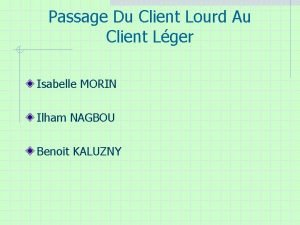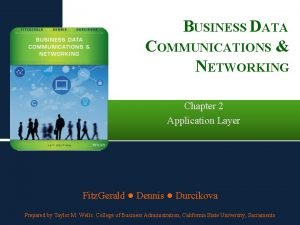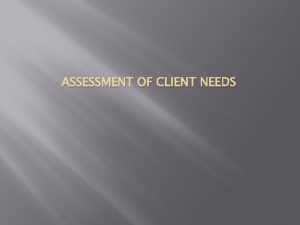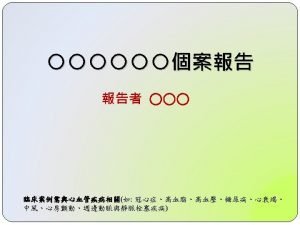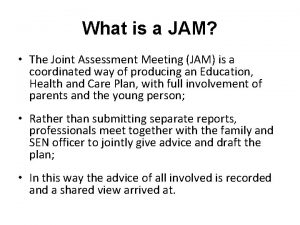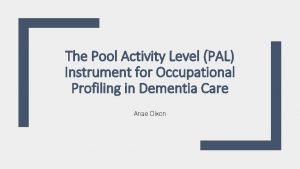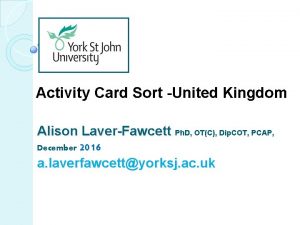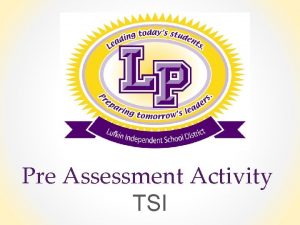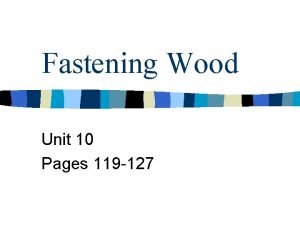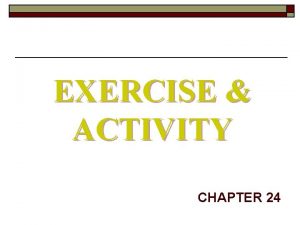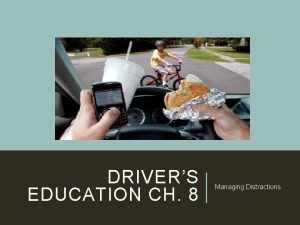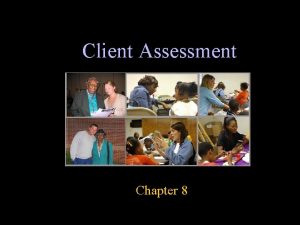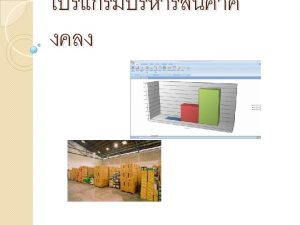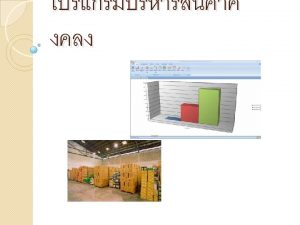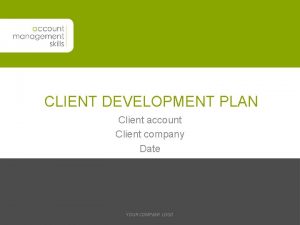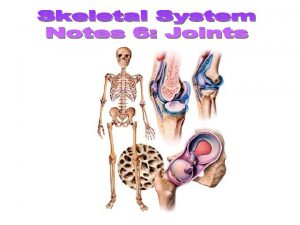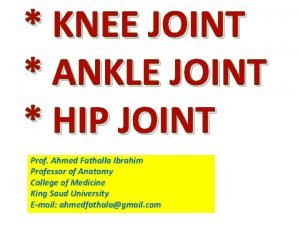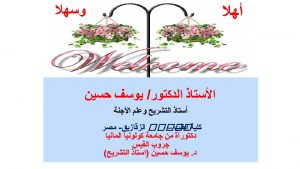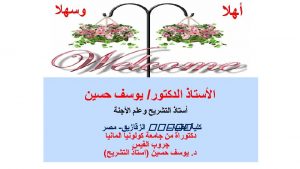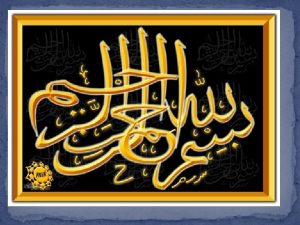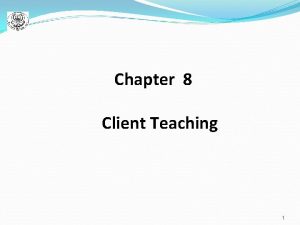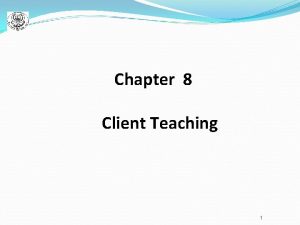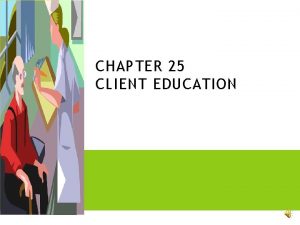Client Assessment Chapter 8 A Joint Activity As








































- Slides: 40

Client Assessment Chapter 8

A Joint Activity “As a joint activity by both the social worker and the client, assessment requires their mutual understanding and agreement. ” Cynthia D. Bisman, Social Work Assessment: Case Theory Construction, 1999.

Social Diagnosis “Social diagnosis is the attempt to arrive at as exact a definition as possible of the social situation and personality of a given client. The gathering of evidence, or investigation, begins the process, the critical examination and comparison of evidence follows, and last come its interpretation and the definition of the social difficulty. ” Mary Richmond, Social Diagnosis, 1917

Client Assessment w Assessment is an ongoing process n Dynamic n Multidimensional w Client assessment is a synergistic process that begins before first contact and does not end until the work is completed.

The Assessment Circle client worker related systems The assessment circle represents the interrelated nature of the systems which interact in the assessment process.

General Overview w Introduction to the social work perspective and purpose of assessment. w Assessment skills and tools. w Gathering and organizing assessment information. w Introduction to the medical model. w Initial assessment formation. w The DAC model. w Theory & Conceptualization

Assessment Constraints and Factors of Influence w model of practice w agency purpose and mission w philosophy w agency contractual considerations w client contractual considerations w access w time w resources

Assessment Tools w Standardized w Graphic representations w Written w Historical w Theoretical w Personal interaction w Professional & paraprofessional w Use of self

Standardized Tools w Standardized tests, interviews and agency forms n standardized instruments l Beck depression inventory l MMPI l Rorschach l Intelligence tests l Child Behavior Checklist l ASIS w There are many commercial tests and assessment instruments in use. Some of these instruments must be administered or interpreted by a licensed psychiatrist, psychologist, or other specially trained personnel.

Beck Depression Inventory w The Beck Depression Inventory is both valid and reliable. It was created by Aaron Beck who was doing research on cognitive treatment of clinical depression. He was forced to create a means of testing for depression when he discovered that no other reliable instrument existed.

The BDI w Take a few moments to look at the BDI. n http: //www. ibogaine. desk. nl/graphics/3639 b 1 c_23. pdf w Do you think that the BDI is a reasonably accurate measurement of depression? w Do you see any problems with this instrument that might effect accuracy?

The Rosenberg Scale w The Rosenberg Scale is freely available and in the public domain. It is another example of a standardized tool that you can use when working with clients. w Rosenberg Scale n http: //www. atkinson. yorku. ca/~psyctest/rosenbrg. pdf

Graphic Representations w Examples n time line n eco-map n genograms n family sculpting w A powerful assessment tool which are frequently constructed by social workers in collaboration with the client. w The process of constructing a graphical representation frequently enhances therapeutic relationship and is often an enjoyable and goal directed activity for client and worker.

Sample Eco-maps and Resources http: //www. dss. mo. gov/cd /info/cwmanual/section 7/c h 1_33/sec 7 ch 25. htm http: //www. ohiocla. com/ Year%205%20 Revisions/ ecomap 1. htm

Sample Personal Timeline

The Chronological Timeline Take out a sheet of paper. w Create a chronological timeline of your life. w Do you think that a timeline would be useful in a client assessment? w What are the strengths and weaknesses of a timeline?

Written Assessment Tools w Written n intake & contact forms (usually standardized by the agency) n worker notes (sometimes standardized by the agency particularly for documentation related to financial reimbursement) n problem lists n social history (psychosocial)

Historical Assessment Tools w Historical records are simply documents generated by someone other than yourself. Historical records may, or may not, be available to you. For example: n n n Past records generated and maintained by the agency Records which are sent as part of a referral process Records which are requested, using proper release of information protocols, by the worker or the agency. These records take time and planning to obtain. w Historical records are useful but must be used with caution. Historical records can contain inaccuracies or outdated information.

The Use of Social Work Theory In Assessment w The unique perspective of social work practice is a powerful assessment tool. w Theoretical social work perspectives n PIE: person-in-environment n Strengths perspective n Systems and ecological theory

Personal Interaction & Contact w Your personal interaction is also a valuable assessment tool. During each contact, even telephone contact, you are gathering assessment information. w Personal interaction n formal interventions (during regularly scheduled meetings) n informal contact - These are interactions which occur when greeting the client, giving a tour of the agency, etc. The amount varies from setting to setting.

Professional & Paraprofessional Collaboration w The information you gather from professional personnel (physicians, nurses, teachers, psychologists, speech therapist, etc. ). w The information you gather from paraprofessional personnel (program or case aides, office support personnel). w Supervision & Peer Collaboration w Agency liaison - personnel assigned to the client, to your agency or both. w This important assessment tool is sometimes formalized into treatment teams.

Use of Self w These are your unique personal characteristics and skills. n knowledge, skills and values n experience n specialized knowledge or training n intuitive and deductive reasoning n research

Medical Model In Assessment w Social work is not based on a medical model. w However, ever social worker and client interact with systems which are based in varying degrees on the medical model of practice.

Medical Model: A definition w The medical model of practice is based on the belief that the client has an illness, disease or dysfunction which needs to be treated by trained professionals. w The “patient” is first diagnosed and then treated.

Social Work and the Medical Model w Social workers must coexists, interact, and even work within systems influenced by, or even dominated by, the medical model. w Collaboration with the medical model is possible but social workers must not loose their unique perspective (person-in-environment and holistic approach) or they cease to function as a social worker.

The DSM-IV w The Diagnostic and Statistical Manual, version four, is maintained and published by the American Psychiatric Association. w The manual is written from the perspective of the medical model.

The ICD-9 CM w The International Classification of Diseases, 9 th Revision, Clinical Modification is based on the World Health Organization’s International Classifications of Diseases. w It is designed for classification of morbidity and mortality information as well as statistical purposes. w ICD-9 CM classifications are required by Medicaid and Medicare as well as most insurance companies. DSMIV and ICD-9 CM classifications are roughly the same. However, one should not be used in place of the other. w ICD-9 CM has psychiatric disorders listed in much the same way as the DSM-IV.

DAC Description, Assessment and Contract A Social History, Initial Assessment & Contracting Model

The DAC Social History Model w The DAC social history model has three major divisions: w w w I. Description II. Initial Assessment III. Contract

Description - part I w Description n n Client Identification Systems: l person (micro) l family and household (mezzo) l ecological (macro) Issues of concern Strengths, competencies, and resources Referral source and process/collateral information

Descriptive (cont. ) - Social History w developmental w personal and family w critical life events w sexual w substance abuse w medical/physical w legal w educational w vocational w recreational w spiritual w prior psychological or social service interventions w other

Initial Assessment - Part II w Person n identity and structure n mood and emotion n life cycle development n competence n risk w Environment n resources n social and cultural w Family/Household/Pri mary Social Systems n identity and structure n mood and emotion n life cycle development

Contract - Part III w Issues n client-identified issues n worker-identified issues n agree upon issues for work w Goals w Plans n action plan n client task and action steps n work task and action steps n In-session task and action steps n Maintenance tasks n Plans to evaluate progress

Written Records w Your written notes, summaries and reports are legal documents. w Written work should be n accurate n timely n terse w AVOID verbose, and judgmental writing. w Write nothing that you can not defend to your supervisor, professional organizations, state agencies, the legal system and the client. w Written records can be reviewed, audited or subpoenaed by more people than you might think.

Theory

From Idea to Theory w An Idea is a relatively unstructured thing. However, ideas are the building blocks of conceptualization and conceptualization is the building block of theory. w Theories ad structure and discipline to our ideas.

Conceptualization w The process of assigning words to ideas, abstractions, and constructions of empirical reality.

What is a theory? w Theories are human inventions, nets, that are designed to catch the world. w Karl Popper, philosopher (1988) w In drawing patters from observations to explain phenomena, different persons may explain the same events with a range of theories. The theory is not real but rather is the individual’s attempt to explain real things. Cynthia Bisman, 1999

Theory & Assessment w Theory exists in an individuals overall understanding of the world around them. Why and how things are the way they are. w Theory is created in the assessment process. w Is it possible to separate theory created in assessment from our world view?

Theory Building & Assessment w Theory building is a part of the assessment process. In theory building we develop a conceptualization of the situation. n Cause and effect. n If-then propositions.
 Zero client vs thin client
Zero client vs thin client Client lourd vs client léger
Client lourd vs client léger Thin client vs thick client
Thin client vs thick client Cutability
Cutability Superior costotransverse ligament
Superior costotransverse ligament Permanent fastening methods
Permanent fastening methods Memorandum joint venture account is
Memorandum joint venture account is Lamb carcass grading
Lamb carcass grading Symphyses
Symphyses Social work assessment questions for clients
Social work assessment questions for clients Client needs assessment
Client needs assessment Biochemical data, medical tests, and procedures (bd)
Biochemical data, medical tests, and procedures (bd) Mobilization grades
Mobilization grades Joint assessment
Joint assessment Reactants, products, and leftovers
Reactants, products, and leftovers Activity and activity coefficient
Activity and activity coefficient Aon vs aoa
Aon vs aoa Activity 1 introductory activity
Activity 1 introductory activity Activity 1 activity 2
Activity 1 activity 2 Activity 2:
Activity 2: Activity 1 activity 2
Activity 1 activity 2 Pool activity level
Pool activity level Tcc pre assessment activity
Tcc pre assessment activity Kingdom card sort
Kingdom card sort Pre assessment activity
Pre assessment activity Chapter 10 chapter assessment chemical reactions answers
Chapter 10 chapter assessment chemical reactions answers Chapter 11 study guide stoichiometry
Chapter 11 study guide stoichiometry Chapter 9 chemical reactions test answers
Chapter 9 chemical reactions test answers Chapter 9 surface water answer key
Chapter 9 surface water answer key Chapter 2 study guide representing motion
Chapter 2 study guide representing motion The central science 14th edition
The central science 14th edition Chapter 2 standardized test practice answers
Chapter 2 standardized test practice answers Ionic compound properties
Ionic compound properties Chapter 7 chapter assessment ionic compounds and metals
Chapter 7 chapter assessment ionic compounds and metals Learning principle in portfolio assessment
Learning principle in portfolio assessment Define dynamic assessment
Define dynamic assessment Portfolio assessment matches assessment to teaching
Portfolio assessment matches assessment to teaching Chapter 10 dado joint answers
Chapter 10 dado joint answers Joint design in welding
Joint design in welding Hyperextension
Hyperextension Biomechanical drivers ed
Biomechanical drivers ed

